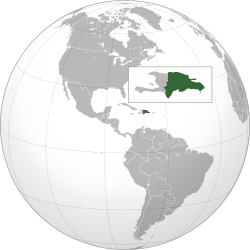Republica Dominicana
|
Dominican Republic
República Dominicana (Spanish)
|
|||||
|---|---|---|---|---|---|
|
|||||
|
Motto: "Dios, Patria, Libertad" (Spanish)
"God, Homeland, Freedom" |
|||||
 |
|||||
| Capital and largest city |
Santo Domingo 19°00′N 70°40′W / 19.000°N 70.667°W |
||||
| Official languages | Spanish | ||||
| Ethnic groups (1960a) | |||||
| Demonym | Dominican | ||||
| Government | Unitary presidential republic | ||||
| Danilo Medina | |||||
| Margarita Cedeño de Fernández | |||||
| Legislature | Congress | ||||
| Senate | |||||
| Chamber of Deputies | |||||
| Independence | |||||
| December 1, 1821 | |||||
| February 27, 1844 (not recognized by Haiti until November 9, 1874)c | |||||
|
• from Spain (restoration)
|
August 16, 1863 (recognized on March 3, 1865) | ||||
|
• from the United States (occupation)
|
July 12, 1924 | ||||
| Area | |||||
|
• Total
|
48,442 km2 (18,704 sq mi) (128th) | ||||
|
• Water (%)
|
0.7 | ||||
| Population | |||||
|
• 2016 estimate
|
10,075,045 (88th) | ||||
|
• 2010 census
|
9,478,612 | ||||
|
• Density
|
197/km2 (510.2/sq mi) (65th) | ||||
| GDP (PPP) | 2016 estimate | ||||
|
• Total
|
$160.86 billion (72nd) | ||||
|
• Per capita
|
$15,946 (76th) | ||||
| GDP (nominal) | 2016 estimate | ||||
|
• Total
|
$71.46 billion (67th) | ||||
|
• Per capita
|
$7,083 (74th) | ||||
| Gini (2012) |
high |
||||
| HDI (2015) |
high · 99th |
||||
| Currency | Peso (DOP) | ||||
| Time zone | Standard Time Caribbean (UTC −4:00) | ||||
| Drives on the | right | ||||
| Calling code | +1-809, +1-829, +1-849 | ||||
| ISO 3166 code | DO | ||||
| Internet TLD | .do | ||||
|
|||||
|
Sources for area, capital, coat of arms, coordinates, flag, language, motto and names:
For an alternate area figure of 48,730 km2, calling code 809 and Internet TLD: |
|||||
Coordinates: 19°00′N 70°40′W / 19.000°N 70.667°W
The Dominican Republic (Spanish: República Dominicana [reˈpuβlika ðominiˈkana]) is a sovereign state occupying the eastern two-thirds of the island of Hispaniola, in the Greater Antilles archipelago in the Caribbean region. The western one-third of the island is occupied by the nation of Haiti, making Hispaniola one of two Caribbean islands, along with Saint Martin, that are shared by two countries. The Dominican Republic is the second-largest Caribbean nation by area (after Cuba) at 48,445 square kilometers (18,705 sq mi), and 3rd by population with approximately 10 million people, of which approximately three million live in the metropolitan area of Santo Domingo, the capital city.
Christopher Columbus landed on the Western part of Hispaniola, in what is now Haiti, on December 6, 1492. The island became the first seat of Spanish colonial rule in the New World. The Dominican people declared independence in November 1821 but were forcefully annexed by their more powerful neighbor Haiti in February 1822. After the 1844 victory in the Dominican War of Independence against Haitian rule the country fell again under Spanish colonial rule until the Dominican War of Restoration of 1865.
...
Wikipedia


